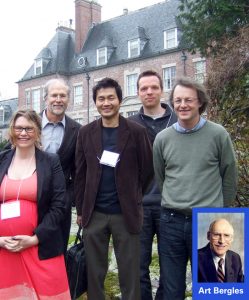Daniel Attinger, associate professor of mechanical engineering at Iowa State, was invited to give a panel presentation on surface sciences at the International Workshop on Micro and Nanostructures for Phase Change Heat Transfer. The workshop was co-organized in Boston by Evelyn Wang from the Massachusetts Institute of Technology (MIT) and Yoav Peles from the Rensselaer Polytechnic Institute. The audience was a group of 60 international scientists, research program directors from government agencies, and large companies.
The workshop kicked off with a lecture from one of the greatest thermal scientists, Art Bergles, on the “modern history of enhanced heat transfer surfaces.” Bergles, a professor and department chair of the ISU Department of Mechanical Engineering from 1972 to 1983, has been the recipient of the highest honors in the field of heat transfer. He is also a member of the National Academy of Engineering.
Bergles’ keynote address at the workshop pointedly mentioned that the potential of nano- and micro-technologies to cleverly enhance phase change heat transfer was only starting to be realized. Specifically, after microchannels were introduced in the early 1980s, there was no noticeable increase in the number of publications on enhanced heat transfer.
In addition to Bergles and Attinger, several attendees at the workshop have ties to Iowa State, as shown in the picture below.

“I work hard to keep up with the great tradition of thermal sciences at Iowa State University,” Attinger said at the start of his presentation. He acknowledged the influence that members of the ISU Mechanical Engineering Department have had on the field of thermal science. For instance, designing enhanced heat transfer surfaces for phase change heat transfer – the very technique elevated as art by Bergles – is critical for addressing energy challenges of the 21st century.
The strong representation of Iowa State at the MIT meeting is no surprise to Ted Heindel, the Bergles Professor of Thermal Science and ME professor at Iowa State.
“Daniel is one of the 15 members of the thermofluids group in Mechanical Engineering at ISU,” Heindel said. “That group has a strong tradition dating back even before Art Bergles, and Daniel’s contributions continue in this tradition.”
Attinger was thrilled after receiving his invitation to present at the workshop.
“I could not believe that I would be one of the three panelists, with Van Carey on my right and David Quéré on my left – they lead the field,” he said. “They respectively wrote the best books I could find for teaching my graduate class and for my research on boiling!”
During his panel presentation, Attinger advocated for more research on superbiphilic surfaces. His recent work with Kim and Betz (see photo) has shown that these surfaces with spatial patterns of wettabilities best manage the complex and dynamic interplay of liquid and vapor during boiling. When a research program director objected to Attinger that these nanostructured surfaces only work with water, while real technological applications require other fluids like refrigerants, Attinger replied that within 5 years these nanostructured surfaces would work with refrigerants. He added that the scientist who would succeed in this endeavor was probably in the room, and that realizing this dream would only be possible if enough money was provided to the scientific community. To this, the MIT room cheered to the words of the faculty member from Iowa State.
Bergles’ presentation concluded by noting that he had spent most of his career working at the mini and micro scale. His legacy is now revisited by the nanotechnologists — in much the same way as the Lilliputians captured and honored Gulliver.